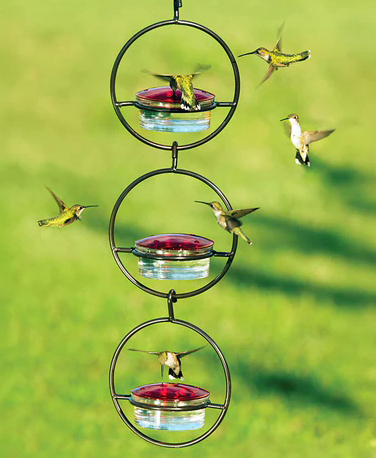
A popular combination feeder is the Duncraft Cardinal Shield Hopper & Suet Feeder, here being visited by a Northern Cardinal and a Downy Woodpecker.

A Sphere Hummingbird Feeder would be an attractive addition to any feeding station, and it is a good example of a simple, tasteful feeder that would be a welcome addition to a business location (photos by Duncraft).
|
It’s always fun to see another birders’ feeding station as you walk or drive through a residential area, or to view the birds at feeders when you visit a nature center, Audubon center, or national wildlife refuge. While not all of the public areas have a feeding station, that’s part of the treasure hunt – kinda like a scavenger hunt or a “Where’s Waldo” session – in which you look for the next feeding station. Why search for another feeding station? You can get ideas from other feeding stations you find or stumble upon, and see what birds are visiting, what foods are being offered, what kinds of feeders are being used, and are the birders offering water in a birdbath or at a water feature with a trickle of sound included.
As we all know, each feeding station tends to be unique, created with varied feeder models, colors, and designs, along with relatively unique birdbaths or other water features. It’s interesting to see the types of foods being offered too, plus the associated landscaping, and it’s fun to see how it all ties together in a yard or public space. It can be a bit like window shopping to get an idea of what birds are being attracted to different foods, the different models of feeders being used to present the foods, as well as the overall layout of a feeder complex.
Feeding stations are in many ways anchors for birds and birders – centers of activity for local birds and a valued find for migrating birds on the move looking for an oasis with food and water. Some schools may have a feeding station to help introduce students of varied ages from preschools to elementary, middle schools, high schools, and colleges. It just takes one teacher to add a feeding station that others can appreciate and enjoy, while inspiring an interest in birds among some students, and giving others a window into nature.
Public and private access feeding stations are also sprinkled among varied business locations, where some birders have extended their interests in birding beyond home to work. A work feeding station may begin simply, with an ornamental birdbath or a hummingbird feeder, and it may grow with time and interest among co-workers. A workplace feeding station can attract a different mix of birds, which can make feeding station at a place of work a bit more interesting. As you look for the potential of a feeding station at area businesses, a good bet is that a local Wild Birds Unlimited store or a birding optics store will have a feeding station on hand to attract birds and birders.
Some assisted living homes and care facilities have added bird feeding stations that add a lively window into nature for residents, visitors, and staff – and you might find one outside a hospital or clinic waiting room too. Frankly, you never know where you will find an interesting feeding station, and who knows, you may even be able to share a few insights and strike up a conversation.
While many birders prefer to keep their feeding station in their backyard, some birders like to share their interest in birds with others by positioning their feeding station in full view from the sidewalk and street. For example, our editor has his feeding station positioned so people walking or driving by can view the setup and the different birds that visit. It’s a great way to promote your interest in birds and perhaps even inspire other people to begin offering food and water to birds. It’s also a forum to spark conversations about birds, including local birds that people see in their yards – everyone has personal bird stories, questions, and phone pictures to share.
Bird feeders can be a catalyst that interests new people in birds, and inspires them to enter the path of birding. Theoretically, each feeding station could inspire a few new active birders who set up their own feeding station, start keeping bird lists, and begin to use eBird. They may soon join in local birding walks and graduate to field trips to learn the basics of birding and appreciate the social aspects of the activities; eventually some may join a local birding club or Audubon chapter.
For families, a feeding station can be a rallying point of sharing between generations, and it can be a place that children learn and enjoy the daily responsibility to replenish foods and add fresh water on a regular basis. Birding has no bounds, and it attracts a great cross-section of people across the country and around the world. Enjoy your feeding station, share your enthusiasm for birds, and experience birding with renewed vigor during this wonderful time of the year.
Share your backyard birding experiences and photographs with The Birding Wire at editorstbw2@gmail.com